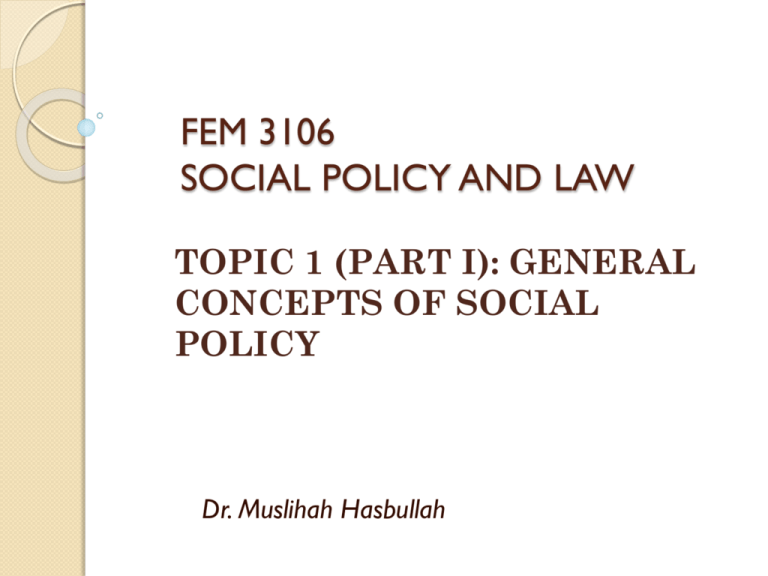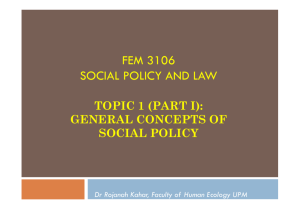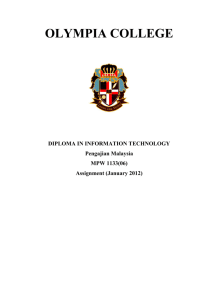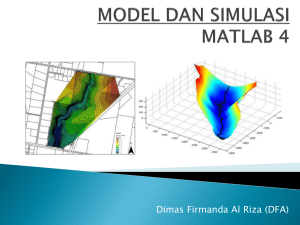policy
advertisement

FEM 3106 SOCIAL POLICY AND LAW TOPIC 1 (PART I): GENERAL CONCEPTS OF SOCIAL POLICY Dr. Muslihah Hasbullah CONTENT Definition of Policy & Social Policy 2. Purposes of Social Policy 3. Relationships Between Policy, Issues, and Problems 4. Process of Policy-making 5. Categories of Public Policy 6. Categories of Malaysian Public Policy 7. Implementation of Government’s Policies 8. Policy and Law 9. Basic Criteria of Law 10. Social Functions of Law 11. Legal Terminology 1. DEFINITION OF POLICY When the term policy is used, it may refer to: 1. Official government policy (legislation or guidelines that govern how laws should be put into operation). 2. Broad ideas and goals in political manifestos and pamphlets. 3. A company or organization's policy on a particular topic. eg; policy for equal opportunity where the company aims to treat it staff equally. DEFINITION OF SOCIAL POLICY A declaration by the government (aims & ideology) makes from time to time to resolve issues or to fulfill objectives. Sesuatu digubal untk m’nyatakan tujuan & matlamat kerajaan (Negara Kita, 1980). Government’s choice to do or not to do something (Dye, 1984). The course of actions of the government towards the people – that involve specific planning – the public needs have to be analyzed before actions are taken (Helco, 1972). PURPOSES OF POLICIES To increase efficiency To decrease management cost To resolve problems As a basis of administration state/organization As a guide to achieve objectives A good moral value to the public for WHY WE NEED TO UNDERSTAND THE POLICIES? To arrange a program and the strategic plan to achieve objectives. To resolve issues and conflicts that might happen while implement the policies. For those who are directly involve in the implementation of the policies (civil servants) as well as the people (those who are affected by the policies). RELATIONSHIPS BETWEEN POLICIES, ISSUES, AND PROBLEMS POLICIES ISSUES PROBLEMS POLICY-MAKING PROCESS Sultan Kabinet/Elit Profesional/Pentadbir Rakyat 4 CATEGORIES OF PUBLIC POLICIES 1.Regulatory policies 2.Redistributive policies 3.Distributive policies 4.Security and defense policies REGULATORY POLICIES Government limits on individual choice in order to restrict unacceptable behavior. Policies to administer organizations (public/private) and also individual. The basic thing about this type of policy – to enact law / regulations. The law will be explained, implemented, and evaluated. Eg:Acts; Kepimpinan Melalui Tauladan REDISTRIBUTIVE POLICIES The government taxes one group of people in order to provide benefits to another group. Eg: taxes, subsidies DISTRIBUTIVE POLICIES Government efforts to distribute benefits to some portion of the population and pay for those benefits from general tax revenues. It extends goods and services to members of an organization, as well as distributing the costs of the goods/services amongst the members of the organization. Examples include government policies that impact spending for welfare, public education, highways, and public safety, or a professional organization's benefits plan. Dasar Ekonomi Baru. SECURITY AND DEFENCE POLICIES For preservation of national security and protection of national strategic interests (in the area of immediate vicinity, regional, and global). Eg; Immediate vicinity interests: comprise the land territories, territorial waters, airspace, the Exclusive Economic Zone (EEZ), the Straits of Malacca and its approaches, and the Straits of Singapore, the sea and air lines of communication connecting Peninsular Malaysia and Sabah and Sarawak. Eg; regional interests: Malaysia shares either common land or sea boundaries or both with most of the ASEAN states. Any infringement to the region's security will have consequential effects on Malaysia's security. Eg; Global interests: growing trade links, new markets for its products, increasing foreign investment and the acquisition of private enterprises with worldwide interests have broadened its interests beyond the immediate vicinity and the region. Cth: Dasar Luar Negara 3 CATEGORIES OF MALAYSIAN POLICIES Economic policies Social and work ethics policies Foreign affairs policies ECONOMIC POLICIES Dasar Pembangunan Nasional Rangka Rancangan Jangka Panjang Kedua Dasar Perindustrian Negara Dasar Pertanian Negara Dasar Penswastaan Dasar Pensyarikatan Malaysia Dasar Halacara Baru Dalam Pembangunan Kampung Dan Luar Bandar Dasar Pengurangan Perbelanjaan Awam Dasar/Program Pembaharuan dan Peningkatan Daya Pengeluaran Negara SOCIAL AND WORK ETHIC POLICIES Dasar Pendidikan Kebangsaan Dasar Kebudayaan Kebangsaan Dasar Penerapan Nilai-Nilai Murni Dalam Pentadbiran Dasar Pandang Ke Timur Dasar Bersih, Cekap Dan Amanah Kepimpinan Melalui Teladan FOREIGN AFFAIRS POLICES Konsep Kawasan Aman, Bebas Dan Berkecuali (ZOPFAN) Antartika Rancangan Kerjasama Teknik Malaysia (MTCP) IMPLEMENTATION OF POLICY DASAR Undang-undang PERLAKSANAANNYA Dasar dalam bentuk perundangan yang digubal untuk membendung masalah sosial. Dasar bentuk ini sukar untuk diubah/mansuh Konsep hukuman dalam perlaksanaan Undang-undang: oleh Parlimen. Enakmen: DUN, Ordinan: undang-undang sebelum merdeka. Rancangan Dasar bentuk ini lebih terperinci (merangkumi pelbagai masalah sosial) Mengandungi Strategi Program pelbagai dasar percapaian adalah melalui program & projek Dibentuk untuk mengurus masalah sosial Tidak gunakan pendekatan hukuman Projek Berbentuk khusus Merupakan sebahagian daripada program (Jangkamasa lebih pendek) 1. LAWS In legislative form. Concept of punishment is implemented. Once approved, it is not easily change or repealed. Eg:Acts, Enactments 2. PLAN More detail. May include several policies. Achievable through strategies such as program or projects. 3. PROGRAM To resolve social issues. No punishment involve. 4. PROJECT A specific policy. Part of a program but it is implemented in a shorter period. Dasar Wanita Negara Undang-undang: Akta Keganasan Rumahtangga; Akta Kanak-Kanak 2001 Rancangan: HAWA Program: Masyarakat Penyayang Projek: Hari Wanita Sedunia Dasar Ekonomi Baru (1971-1990) Strategi pembangunan baru selepas peristiwa berdarah 13 Mei 1969 Asas pembangunan ekonomi dan sosial negara DEB dilaksanakan di bawah RRJP1 Tumpuan kepada pembasmian kemiskinan, pengangguran serta memperbaiki ketidakseimbangan dari segi kedudukan ekonomi antara kaum Objektif DEB Pembasmian kemiskinan di kalangan rakyat tanpa mengira kaum Penyusunan semula masyarakat a) Mengurangkan jurang perbezaan - Antara wilayah dan kaum -Dari segi pendapatan, gunatenaga, hakmilik dan kemudahan asas b) Menghapuskan pengenalan kaum mengikut fungsi-fungsi ekonomi dan kawasan Dasar Pembangunan Nasional (1991-2000) Objektif DPN: Membina sebuah negara yang bersatu padu Mengekalkan Ekonomi Yang Berterusan Menjadikan Malaysia Sebuah Negara Maju Mewujudkan Sebuah Masyarakat Yang Lebih Adil, Beretika, Makmur Kecekapan Pentadbiran Kerajaan Program dilaksanakan melalui DPN Hasil pencapaian yang berkualiti berkekalan Persaingan dalam Pasaran Antarabangsa Wawasan 2020 Pembasmian kemiskinan Penyusunan Semula Masyarakat Dimensi baru dlm DPN: dan ◦ Tumpuan kpd golongan termiskin ◦ Penekanan penglibatan sektor swasta ◦ Pembangunan sumber manusia termasuk sistem nilai & etika ◦ Pembentukan Masyarakat Perdagangan & Perindustrian Bumiputera INDUSTRIAL POLICIES Corak perindustrian negara: 50an – Getah dan Bijih Timah 60an – Gantian Import 70an – Mempelbagaikan Ekonomi 80an – Industri Berat 90an – Peranan Swasta dan Pelaburan Asing WHY DO WE NEED INDUSTRIAL POLICIES? Kemelesetan ekonomi tahun 80-an Kelemahan sektor perindustrian Menyahut cabaran DEB Peluang pekerjaan dan tenaga mahir Pertumbuhan ekonomi seimbang Pertumbuhan industri kecil dan sederhana Ke arah modenisasi Penyumbang utama sektor ekonomi masa hadapan Persaingan antarabangsa Pertumbuhan bandar-bandar baru Ke arah negara maju Dasar wawasan negara (2001-2010) Menentukan arah pembangunan negara dlm dekad pertama abad ke-21 Objektif: Mencapai pertumbuhan mapan dan pengukuhan daya tahan ekonomi Mewujudkan masyarakat yg bersatu padu dan saksama DWN menggabungkan teras kritikal dasar pembangunan yg lepas iaitu DEB & DPN Juga berpandu kpd cabaran strategik Wawasan 2020 Teras kritikal dasar wawasan negara Membina bangsa yang berdaya tahan dengan memupuk perpaduan. Menyemarakkan semangat patriotik, membentuk kematangan politik, membina masyarakat supaya lebih bertolak ansur dan penyayang juga tersemat dengan nilai positif dan meningkatkan kualiti hidup dan keutuhan ekonomi. Mengekalkan pertumbuhan ekonomi yang tinggi dengan memperkukuhkan sumber pertumbuhan, institusi kewangan dan korporat serta pengurusan ekonomi makro. Mempertingkatkan daya saing untuk menghadapi cabaran globalisasi dan liberalisasi. Membangunkan ekonomi berasaskan pengetahuan sebagai satu langkah strategik untuk meningkatkan nilai ditambah bagi semua sektor ekonomi dan mengoptimumkan daya pemikiran rakyat. Mengukuhkan pembangunan sumber manusia untuk menghasilkan tenaga kerja yang cekap, produktif dan berpengetahuan. Meneruskan pembangunan alam sektor yang mapan untuk meneguhkan pertumbuhan jangka panjang. Dasar sosial negara Dasar pembangunan sosial berteraskan nilainilai murni dan peningkatan keupayaan insan Untuk mencapai kesepaduan dan kestabilan sosial, ketahanan nasional, dan kesejahteraan masyarakat Diluluskan pd 19 FEB 2003 untuk mencapai matlamat mewujudkan masyarakat Malaysia yg mapan dan maju dr aspek; ◦ Sosial ◦ Ekonomi ◦ teknologi 4 objektif khusus DSN Memastikan keperluan asas individu, keluarga dan masyarakat dipenuhi Membangun dan memperkasakan insan sepanjang hayat Memperkukuh dan membangunkan sistem sokongan sosial & perkhidmatan sosial Menjana sinergi multisektor FAMILY POLICIES Zimmerman (1992) defined family policies as every every actions undertake by the government for the family institutions. The policies implemented either directly of indirectly affects the families. The purposes of family policies: ◦ To help the family ◦ To control the family ◦ To change the negative trend CONCLUSIONS Policies, issues, and problems are inter related. 4 categories of public policies – regulatory, distributive, redistributive, and security and defense policies. 3 categories of Malaysian policies – economic, social and work ethic, and foreign affairs policies. Policies are supported and implemented through several ways: laws, plans, programs, projects. Policy-making and its implementation – a dynamic process – in line with the socio-economic values and political situations of the country. Public policies change following the norms of the society and leaders of the state. TOPIC 1 (PART II): GENERAL CONCEPTS OF LAW Dr. Muslihah Hasbullah POLICIES & LAWS What is the relationship between policies and law? law is one of the methods how the government implement the public policies. Hickling (2001): law according to the modern society refers to the laws enacted by the legislative bodies (parliament) which include order, practice directions and principles that control the behavior of individuals, agencies, corporation and the society. Law is a set of rules. Govern the pattern of behavior in a given society The body of principles recognized and applied by the state in the administration of justice. Emphasis on the ideas of justice and peace. THEORIES OF LAW Natural Law (T.Aquinas): ◦ Divine law ◦ Emphasis on moral and justice Legal Positivism (John Austin): ◦ Command from sovereign authority in a society ◦ Implemented through enforcement & punishment Legal Positivism (Hart): ◦ A specific system of rules that govern the society so that they can live in peace ◦ Primary rules ◦ Secondary rules BASIC CRITERIA OF LAW Consistent – no two conflicting laws. Universal – acceptable to the people with similar characteristics and live in a similar environment. Published – so that it can be understood by the laymen through the legal interpretation. Accepted – the people can obey the law. Enforced – people should know that disobedience of law leads to loss of time, money, and freedom of life. SOCIAL FUNCTIONS OF LAW Pervasive influence in our life affecting almost everything we do: 1. Social control 2. Conflict resolution 3. Instrument of social change: social engineering and social welfare SOCIAL CONTROL Process of which individual are influenced to conduct themselves in conformity to society’s expectations. Conformity to social norms can be explained in terms of 2 social control processes: internal and external. Internal control: those that exist within the individual’s moral and social values of behavior. Develop through socialization process – theory of human ecology. External control: those that comes from outside an individual – pressures and sanctions that are applied by others. Informal sanctions: values, ethics, mores, folkways. Formal sanctions: explicit rules of conduct, planned use of sanction to support the rules and designated individuals to enforce the rules; criminal law – penal or nonpenal sanctions. CONFLICT RESOLUTION To provide legal means by which conflicts can be settled. Methods: formal and informal. Law provide sanctions that create an environment of confidence and induce to parties in conflict to enter into transaction's in reliance of law’s ability to protect their interests. Physical force. Self-help. Court adjudication. Administrative adjudication Alternative dispute resolution INSTRUMENT OF SOCIAL CHANGE Factors of social change: natural, demographic cultural, technological and economic. Should law be used to change society? Does law lead in the process of social change or does social change originate in the larger society and law simply follows the change by merely adjusting or accommodating itself to changes taking place in society? Efficacy of law as an instrument of change? To render justice. To recognize and define legal relationship. To determine legal personality. To resolve disputes in society. To balance conflicting individual/societal interest. To engineer society. PREREQUISITES FOR EFFECTIVENESS OF LAW The source must be authoritative and prestigious. The new law must be compatible with established values. The law must be viable and practical. The aim of the law must be achieved in relatively short time after its enforcement. The enforcement individual/agencies must be committed to the behaviour prescribed by the law. The enforcement should be uniform. The law should include positive and negative sanction. Effective protection should be provided for the rights of those who stand to lose as a result of evasion or violation of the law. The goal of the law must be attainable. The law must be clear and precise. The law must be communicated to the people. The law must reflect the notion of fairness and justice. The law must be supported by an efficient judicial system, police force and administrative machinery. Depends on the extent to which people are motivated to invoke law in support of their interests. Depends on how law is put into effect. LEGAL TERMS Plaintiff – claimant, complainant, petitioner in civil actions. Defendant – person defending or denying. Prosecutor – one who prosecutes another for a crime in the name of the government. Accused– person charged with a crime. Summon – notice to appear, require to attend, subpoena Charge – specific statement of what crime the party is accused contained in a criminal complaint. Conviction – found guilty / admitted to have committed the crime. Warrant – a written order issued by court to search an individual/ premise or to bring a person before a court. Petitioner – One who presents a formal, written application to a court, officer, or legislative body that requests action on a certain matter. Respondent – the person against whom relief is sought, or who opposes the petition. Appellant – A person who, dissatisfied with the judgment rendered in a lawsuit decided in a lower court, asks a superior court to review the decision. CONCLUSION Law permeates all form of social behavior. Its social significance and prevalence are felt in walks of life. In subtle as well as not so subtle ways, a complex and voluminous set of laws governs our every action. Law does not work only by straight forward command; it works alongside the moral, religious and economic forces silently operating in the society. Law has a relationship with other social forces and must be seen as largely dependent on them.








